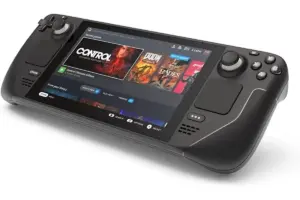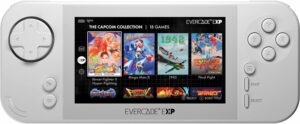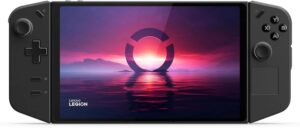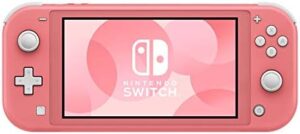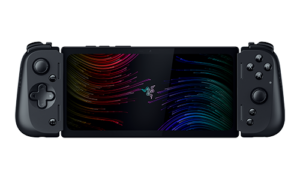There are more gaming handhelds to consider these days than just the Nintendo Switch.
Compare handheld gaming consoles and devices
Gaming handhelds haven’t gone away since the advent of the Nintendo Game Boy. But while the smaller-scale handheld is less popular these days, more powerful handheld game consoles are being released to meet demand in a very competitive space. Let’s take a look at all of the different gaming handheld categories and what you need to know about them.

Compare the best handheld gaming devices
Before we dig into the differences between each type of handheld gaming experience available these days, check out the table below for a quick glance at our top picks for the best handheld gaming consoles and devices your money can buy.
Gaming handheld consoles
While technically this trend started with the Nintendo Wii U, it’s the Nintendo Switch that’s shown the world just how appealing gaming handhelds are. Despite a range of gaming handhelds, the Switch is still peerless in the console space in that it’s really the only mainstream handheld on the market.
If you’re after a Nintendo Switch, you can buy a cheap Switch Lite model, a pricier Switch OLED with a great screen or a base model that sports longer battery life over the original Nintendo Switch release. Games are playable in handheld mode at 720p with removable side-mounted Joy-Cons that also work as standalone controllers. Alternatively, connect the Nintendo Switch to a dock for playing on a TV at resolutions up to 1080p.
In terms of gaming options, you’re looking at 10,000+ titles to choose from. Switch games are either digitally downloaded or installed and played via plastic cartridges. Overall storage is also expandable via MicroSD card (up to 2TB).
Gaming handheld PCs
These days, most competition for the Nintendo Switch in this form factor comes from handheld PCs. Valve’s Steam Deck is the big name in handheld PCs, though it’s heavier and pricier than the Nintendo Switch. The Steam Deck’s controllers are also fixed but that’s about where the cons end in terms of comparisons.
Nowadays, Steam Deck is available with LED or OLED screens, with the latter a slight upgrade over the launch models in terms of performance. Steam Deck owners have access to 13,000+ verified or playable games from the Steam library but that’s just scratching the surface of the Deck’s versatility. Running a SteamOS custom version of Linux, the Steam Deck is very open to expansion. You can, for instance, install Windows on it, play games from non-Steam digital libraries or use the Deck to play emulated games. Steam Deck games run at 800p on the handheld but can output at 4K (for games that will run) with a separately purchased dock.
Such is the popularity of the Steam Deck that a range of competitors have arrived, most of which run on Windows. The benefit of Windows handheld PCs is they can effectively play any game that runs on Windows without having to tinker like you do on Steam Deck. Contenders for Steam Deck’s dominance include the Asus ROG Ally, Ayaneo 2, OneXPlayer, Lenovo Legion Go and upcoming MSI Claw.
Gaming handheld mobile devices
Technically, pretty much any modern smartphone or tablet is a handheld gaming device. Just jump onto the Apple or Google Play Store, download a game, and get playing. The thing is, precious screen real estate is taken up by touch controls, which can make gaming trickier on smaller phone screens in terms of visibility or on tablet screens in terms of comfort. Generally, the specs of mobile gaming devices are comparable to smartphones and tablets, relative to their age and their price.
While you can use a wireless Bluetooth controller for compatible games, backbone controllers are what truly convert mobile devices into gaming handhelds. At their most extreme, you get things like the Razer Edge, which is a combination of custom tablet designed to fit perfectly inside the Razer Kishi V2 Pro backbone controller.
These types of backbone controllers are generally built to comfortably connect to compatible smartphones, and then use their charging ports for more responsive connectivity. Alternatively, there are handsets like the Asus ROG Phone 7 Ultimate that add physical controls to an externally attachable cooling fan. Basically, backbone controllers are a great way to keep smudges off the screen and offer more responsive input compared to Bluetooth controllers, not to mention you don’t have to lug a larger separate controller around just to play.
Backbone controllers are also a straightforward way to turn a mobile device into a streaming device, be that for local consoles or games streamed over the internet. For a very specific device, there’s the PlayStation Portal, which is designed exclusively to stream PlayStation 5 games on your home network. Consider the Razer Edge or other gaming-capable smartphones/tablets, though, for a range of streaming applications, including PlayStation and Xbox, as well as cloud services like Xbox Cloud Gaming, Parsec and GeForce Now.
Gaming handheld retro devices
In 2003, Nintendo released the Game Boy Advance SP before the Game Boy brand was retired and Nintendo’s handheld focus shifted to its DS range. Nowadays, the Game Boy lives on if only in form factor. These retro handheld devices are typically less powerful than all other gaming handhelds listed above and are primarily built to play older games.
The design aesthetic tends to be very Game Boy-like with a limited selection of D-pad and button inputs on the bottom half of the front panel with the rest of that panel occupied by the screen. There are options like the Analogue Pocket, which is built to support cartridges from yesteryear, the Evercade EXP that sports its own game cartridges, or others that are built to play digital games.
You can find ones that are basically emulation machines or other ones with licensed games, like the Capcom Super Pocket. For something more unique, you may consider the low-res Playdate, which has its own games and a unique side-mounted crank for certain contextual controls.
Which gaming handheld is right for me?
The right gaming handheld for you is one that factors in your budget and the type of games you like to play. Start comparisons with the Nintendo Switch, which has a comparatively reasonable entry price (under $500) in the gaming handheld space, capable of being played in handheld or traditional console modes connected to a TV.
If you spend a lot of time playing mobile games, consider a mobile device like the Razer Edge. These more tablet-type gaming handhelds are a better way to play mobile games, plus there are cost-effective options for cloud gaming or streaming games from the platforms you already own. Alternatively, for a throwback, a retro gaming handheld is an affordable way to play old-school games.
You should only consider a gaming handheld PC if you’re serious about your gaming and don’t mind spending some serious cash to back that up. Prices start near the $1,000 mark for a Steam Deck or similarly priced competitor, but the cost can stretch beyond double that if you want more handheld performance.
Gaming handheld frequently asked questions
Related Articles




